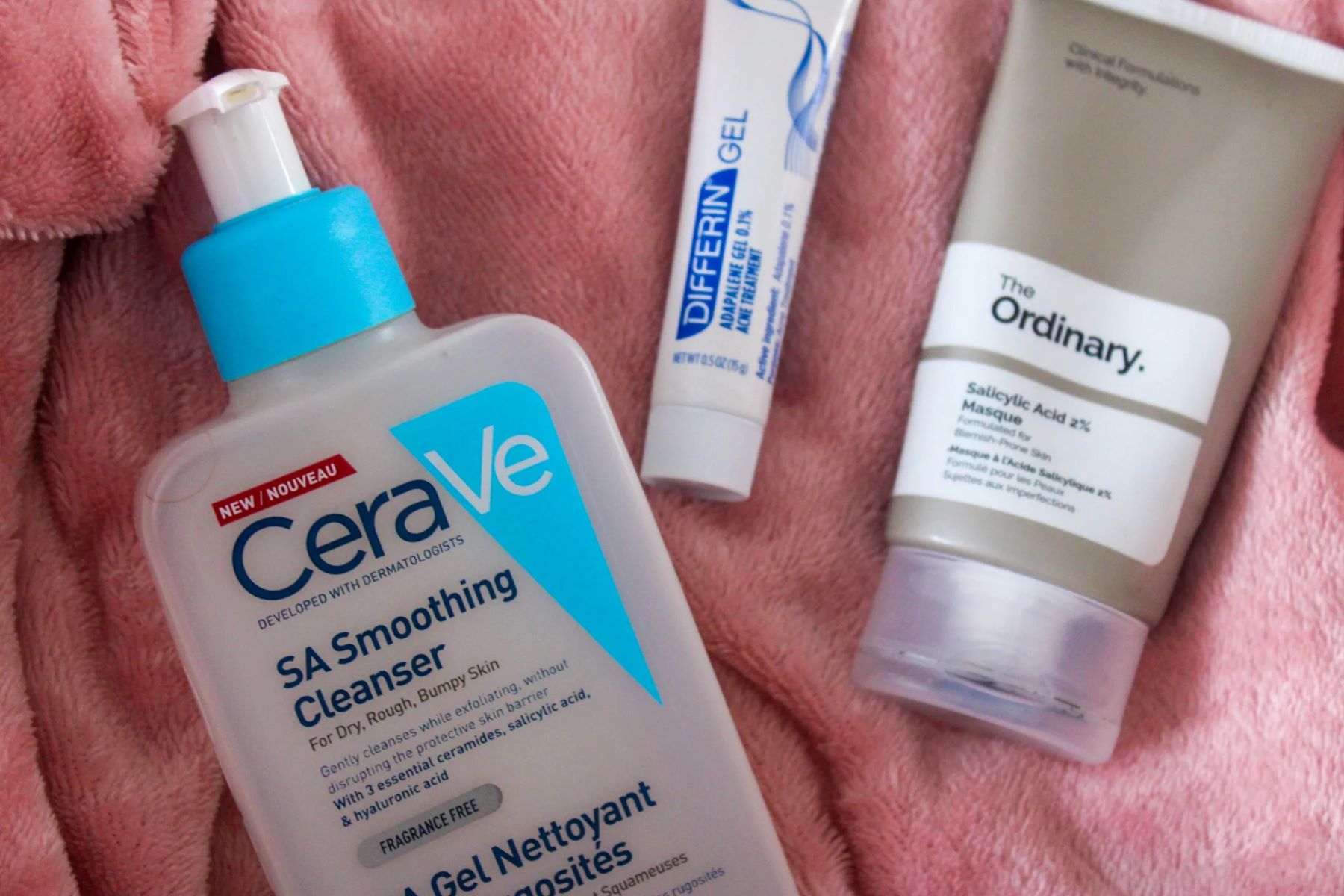Home>Health and Wellness>The Ultimate Skincare Routine For 13-Year-Olds With Dry And Sensitive Skin!


Health and Wellness
The Ultimate Skincare Routine For 13-Year-Olds With Dry And Sensitive Skin!
Published: January 27, 2024
Discover the perfect skincare routine for 13-year-olds with dry and sensitive skin! Take the first step towards health and wellness with our expert tips.
(Many of the links in this article redirect to a specific reviewed product. Your purchase of these products through affiliate links helps to generate commission for Regretless.com, at no extra cost. Learn more)
Table of Contents
Introduction
Taking care of your skin is an essential part of self-care, and it's never too early to start. As a 13-year-old with dry and sensitive skin, finding the right skincare routine can make a world of difference in maintaining a healthy and radiant complexion. Understanding your skin's unique needs and nurturing it with the right products can help you feel confident and comfortable in your own skin.
In this comprehensive guide, we will explore the ultimate skincare routine tailored specifically for 13-year-olds with dry and sensitive skin. From gentle cleansing to nourishing moisturization and sun protection, we will delve into the essential steps to keep your skin happy and hydrated. Additionally, we will highlight special care tips to address the specific challenges that come with dry and sensitive skin at this age.
Embarking on a skincare journey at 13 can lay a strong foundation for lifelong habits that promote skin health and overall well-being. By following this tailored skincare routine, you can embrace a positive relationship with your skin and cultivate habits that prioritize self-care and confidence. Let's dive into the world of skincare and discover the transformative power of a personalized routine designed to cater to the unique needs of dry and sensitive skin.
Understanding Dry and Sensitive Skin
Dry and sensitive skin requires special attention and care to maintain its natural balance and health. At 13, hormonal changes can influence skin condition, making it more prone to dryness and sensitivity. Understanding the characteristics of dry and sensitive skin is crucial in selecting the right products and establishing an effective skincare routine.
Characteristics of Dry and Sensitive Skin
Dry skin lacks the necessary moisture and may feel tight, itchy, or rough. It can also appear dull and flaky, especially in areas such as the cheeks and around the eyes. Sensitive skin is prone to irritation, redness, and reactions to certain products or environmental factors. These characteristics can make skincare a delicate and challenging process, requiring gentle and soothing solutions.
Triggers for Dry and Sensitive Skin
Several factors can exacerbate dryness and sensitivity in the skin. Environmental elements such as harsh weather conditions, low humidity, and excessive sun exposure can strip the skin of its natural oils, leading to dryness. Additionally, using harsh soaps, hot water, or products with fragrances and chemicals can further irritate sensitive skin, causing discomfort and inflammation.
Importance of Gentle Care
Given the delicate nature of dry and sensitive skin, gentle care is paramount. Opting for fragrance-free, hypoallergenic, and non-comedogenic products can help minimize the risk of irritation and allergic reactions. Choosing skincare products with hydrating and soothing ingredients, such as aloe vera, hyaluronic acid, and ceramides, can provide much-needed nourishment and relief for dry and sensitive skin.
Understanding the unique needs and vulnerabilities of dry and sensitive skin sets the stage for creating a skincare routine that caters to these specific requirements. By recognizing the triggers and characteristics of dry and sensitive skin, you can make informed decisions when selecting products and implementing a tailored skincare regimen to promote a healthy and balanced complexion.
By understanding the nuances of dry and sensitive skin, you can embark on a skincare journey that nurtures and protects your skin, laying the groundwork for a lifetime of healthy habits and radiant skin.
Cleansing
Cleansing is a fundamental step in any skincare routine, especially for individuals with dry and sensitive skin. At 13, establishing a gentle yet effective cleansing routine can help remove impurities, excess oil, and environmental pollutants without stripping the skin of its natural moisture. Opting for mild, hydrating cleansers specifically formulated for dry and sensitive skin can provide a soothing and nurturing cleansing experience.
Choosing the Right Cleanser
When selecting a cleanser, look for creamy or lotion-based formulas that offer hydrating and calming properties. Avoid harsh, drying ingredients such as sulfates and alcohol, as they can further deplete the skin's moisture and exacerbate sensitivity. Instead, opt for cleansers enriched with nourishing elements like glycerin, ceramides, and soothing botanical extracts such as chamomile or cucumber.
Cleansing Technique
Gently massage the cleanser onto damp skin using circular motions, allowing the product to lift away impurities while maintaining the skin's natural balance. Avoid using hot water, as it can strip the skin of essential oils, leading to further dryness and irritation. Instead, opt for lukewarm water to rinse off the cleanser, ensuring a thorough yet gentle cleansing process.
Read more: Top 10 Epic LEGO Sets For 13-Year-Old Boys!
Frequency of Cleansing
For individuals with dry and sensitive skin, cleansing once a day, preferably in the evening, is often sufficient to remove accumulated impurities without over-cleansing the skin. Over-cleansing can disrupt the skin's natural barrier, leading to increased dryness and sensitivity. However, if you have been exposed to excessive sweat or environmental pollutants, a gentle morning cleanse can help refresh the skin without causing undue stress.
Special Considerations
Incorporating a double cleansing method, using a gentle micellar water or cleansing oil followed by a hydrating cleanser, can effectively remove makeup and sunscreen without causing irritation. Additionally, for those with sensitive skin, performing a patch test before introducing a new cleanser can help identify any potential allergic reactions or sensitivities, ensuring a safe and comfortable cleansing experience.
By embracing a gentle and hydrating cleansing routine tailored to the needs of dry and sensitive skin, you can lay the groundwork for a nurturing skincare regimen that respects and supports your skin's natural balance. Cleansing should be a comforting and replenishing experience, setting the stage for the subsequent steps in your skincare routine to further nourish and protect your delicate skin.
Remember, the goal of cleansing is not to strip the skin but to purify and refresh it, preparing it to receive the benefits of subsequent skincare products. By prioritizing gentle cleansing, you can cultivate a positive relationship with your skin and embark on a journey of self-care that celebrates and cherishes your unique beauty.
Moisturizing
Moisturizing is a crucial step in the skincare routine for 13-year-olds with dry and sensitive skin. Proper hydration not only helps combat dryness but also fortifies the skin's natural barrier, reducing sensitivity and promoting a supple, radiant complexion. At this age, establishing a nourishing and protective moisturizing routine can lay the foundation for healthy skin habits that endure into adulthood.
Selecting the Right Moisturizer
When choosing a moisturizer for dry and sensitive skin, opt for rich, yet non-greasy formulations that provide intense hydration without clogging pores or causing irritation. Look for products labeled as "fragrance-free," "hypoallergenic," and "non-comedogenic," as these are less likely to trigger adverse reactions. Ingredients such as hyaluronic acid, glycerin, shea butter, and ceramides are beneficial for replenishing moisture and fortifying the skin's natural barrier.
Application Technique
After cleansing, gently pat your skin dry with a soft towel, leaving it slightly damp to lock in moisture. Dispense a pea-sized amount of moisturizer onto your fingertips and apply it evenly onto your face using light, upward strokes. Be sure to extend the application to your neck, as this area is also prone to dryness and requires hydration. Allow the moisturizer to absorb fully before proceeding with sunscreen or makeup.
Frequency of Moisturizing
For individuals with dry and sensitive skin, moisturizing twice a day is recommended to maintain optimal hydration levels. In the morning, apply moisturizer after cleansing to prepare your skin for the day ahead. In the evening, following your cleansing routine, apply a slightly thicker layer of moisturizer to support overnight skin repair and rejuvenation. Consistency in moisturizing is key to nurturing your skin's health and resilience.
Special Considerations
During colder months or in arid climates, consider using a humidifier in your bedroom to combat dry indoor air, which can deplete moisture from your skin. Additionally, for those with extremely dry patches or areas of heightened sensitivity, a targeted, emollient-rich moisturizer can provide concentrated relief and nourishment. Always remember to patch test new moisturizers to ensure compatibility with your skin.
By embracing a nourishing and protective moisturizing routine tailored to the needs of dry and sensitive skin, you can nurture and safeguard your skin's health and beauty. Moisturizing should be a comforting and replenishing experience, reinforcing your skin's natural resilience and vitality. Through consistent moisturizing, you can cultivate a positive relationship with your skin, fostering a sense of self-care and confidence that resonates from within.
Sun Protection
Sun protection is a vital component of skincare, especially for individuals with dry and sensitive skin. At 13, establishing a robust sun protection routine is essential to shield your delicate skin from harmful UV rays and minimize the risk of sun damage. The cumulative effects of sun exposure can exacerbate dryness, trigger sensitivity, and accelerate skin aging, underscoring the importance of diligent sun protection practices.
Importance of Sun Protection
UV radiation from the sun can penetrate the skin, causing a range of adverse effects, including sunburn, premature aging, and an increased risk of skin cancer. For individuals with dry and sensitive skin, prolonged sun exposure can further deplete moisture levels and heighten sensitivity, leading to discomfort and potential damage. Therefore, integrating effective sun protection measures into your daily routine is paramount in safeguarding your skin's health and preserving its natural resilience.
Selecting the Right Sunscreen
When choosing a sunscreen for dry and sensitive skin, opt for broad-spectrum formulations with SPF 30 or higher to ensure comprehensive protection against both UVA and UVB rays. Look for sunscreens labeled as "gentle," "fragrance-free," and "designed for sensitive skin," as these are less likely to cause irritation. Mineral-based sunscreens containing ingredients like zinc oxide and titanium dioxide are often well-tolerated by sensitive skin, providing effective UV protection without triggering adverse reactions.
Application Technique
Apply sunscreen liberally to all exposed skin areas, including the face, neck, ears, and any other uncovered areas. Be sure to apply sunscreen at least 15 minutes before sun exposure to allow for optimal absorption and efficacy. When reapplying sunscreen, especially after swimming or sweating, ensure thorough coverage to maintain continuous protection. Additionally, consider using a lip balm with SPF to protect the delicate skin on your lips from sun damage.
Daily Sun Protection Habits
Incorporate sun protection into your daily routine, regardless of the weather or season. Even on overcast days, UV rays can penetrate cloud cover and reach your skin, emphasizing the need for consistent sun protection. Wearing protective clothing, such as wide-brimmed hats and sunglasses, can complement the effects of sunscreen, providing additional defense against UV radiation. Seeking shade during peak sun hours, typically between 10 a.m. and 4 p.m., can further reduce sun exposure and minimize potential damage to your skin.
Special Considerations
For individuals with dry and sensitive skin, selecting a sunscreen that offers hydrating and soothing properties can provide dual benefits, helping to mitigate dryness and soothe sensitivity while delivering sun protection. Additionally, for those with specific skin concerns, such as acne or hyperpigmentation, exploring tinted sunscreens or those formulated to address these issues can offer targeted solutions without compromising sun protection.
By embracing a comprehensive sun protection routine tailored to the needs of dry and sensitive skin, you can fortify your skin's defenses and nurture its health and beauty. Sun protection should be an integral part of your daily self-care regimen, reinforcing your commitment to preserving your skin's well-being and radiance. Through diligent sun protection practices, you can cultivate a positive relationship with your skin, fostering a sense of empowerment and confidence in safeguarding its vitality.
Special Care for Dry and Sensitive Skin
Special care for dry and sensitive skin involves tailored strategies to address specific challenges and provide targeted relief and nourishment. At 13, understanding the unique needs of your skin and implementing specialized care can significantly enhance its health and resilience. Here are essential considerations for providing special care to your dry and sensitive skin:
Gentle Exfoliation
Exfoliation is crucial for removing dead skin cells and promoting cell turnover, but it is particularly important to approach this step with caution for individuals with dry and sensitive skin. Opt for mild exfoliants, such as gentle chemical exfoliators containing alpha hydroxy acids (AHAs) or beta hydroxy acids (BHAs), which help refine the skin's texture without causing irritation or exacerbating dryness. Limit exfoliation to once or twice a week to prevent overstimulation and allow your skin to regenerate naturally.
Targeted Treatments
Incorporating targeted treatments, such as hydrating serums or soothing masks, can provide concentrated care for specific skin concerns. Look for serums containing ingredients like niacinamide, which helps strengthen the skin's barrier and reduce redness, or hyaluronic acid, renowned for its hydrating properties. Additionally, indulging in a weekly hydrating or calming mask can offer a pampering experience while replenishing moisture and soothing sensitive areas, promoting a healthy and balanced complexion.
Avoiding Irritants
Identifying and avoiding potential irritants is crucial for maintaining the well-being of dry and sensitive skin. Steer clear of products containing harsh fragrances, alcohol, or abrasive ingredients that can trigger sensitivity and compromise your skin's natural balance. Opt for minimalist skincare routines and prioritize products with clean, gentle formulations to minimize the risk of adverse reactions and nurture your skin with the care it deserves.
Professional Guidance
Seeking guidance from a dermatologist or skincare professional can provide valuable insights into managing dry and sensitive skin effectively. A professional can offer personalized recommendations, identify underlying skin conditions, and prescribe targeted treatments or skincare regimens tailored to your specific needs. Consulting with a skincare expert can empower you with the knowledge and resources to cultivate a sustainable and effective skincare routine that supports your skin's health and beauty.
By incorporating these specialized care strategies into your skincare routine, you can provide your dry and sensitive skin with the attention and nourishment it requires, promoting a harmonious and resilient complexion. Embracing targeted care fosters a deep connection with your skin, nurturing its well-being and celebrating its unique beauty, setting the stage for a lifetime of healthy and radiant skin.
Conclusion
In conclusion, establishing a tailored skincare routine for 13-year-olds with dry and sensitive skin is a transformative journey that nurtures and protects the skin's health and beauty. By understanding the unique needs and vulnerabilities of dry and sensitive skin, individuals at this age can lay the foundation for lifelong habits that prioritize self-care and confidence. The ultimate skincare routine outlined in this guide encompasses essential steps, from gentle cleansing to nourishing moisturization and diligent sun protection, tailored to address the specific challenges of dry and sensitive skin.
Embracing a gentle and hydrating cleansing routine sets the stage for subsequent skincare steps, ensuring the removal of impurities without compromising the skin's natural balance. Opting for mild, hydrating cleansers and incorporating a double cleansing method can provide a soothing and nurturing cleansing experience, preparing the skin to receive the benefits of subsequent skincare products.
Furthermore, prioritizing nourishing and protective moisturization is vital for combating dryness and fortifying the skin's natural barrier. Selecting the right moisturizer and adhering to a consistent moisturizing routine fosters a positive relationship with the skin, promoting a sense of self-care and confidence that resonates from within.
Additionally, integrating effective sun protection measures into the daily routine is paramount in safeguarding the skin's health and preserving its natural resilience. By selecting the right sunscreen and incorporating daily sun protection habits, individuals with dry and sensitive skin can fortify their skin's defenses and nurture its health and beauty, fostering a sense of empowerment and confidence in safeguarding its vitality.
Moreover, providing special care tailored to the specific needs of dry and sensitive skin, such as gentle exfoliation, targeted treatments, and avoiding potential irritants, enhances the skin's well-being and resilience. Embracing these specialized care strategies fosters a deep connection with the skin, nurturing its unique beauty and celebrating its health, setting the stage for a lifetime of healthy and radiant skin.
In essence, the ultimate skincare routine for 13-year-olds with dry and sensitive skin goes beyond a mere regimen; it represents a commitment to self-care, confidence, and the celebration of individual beauty. By embracing this transformative journey, individuals can cultivate a positive relationship with their skin, laying the groundwork for a lifetime of healthy habits and radiant skin.










